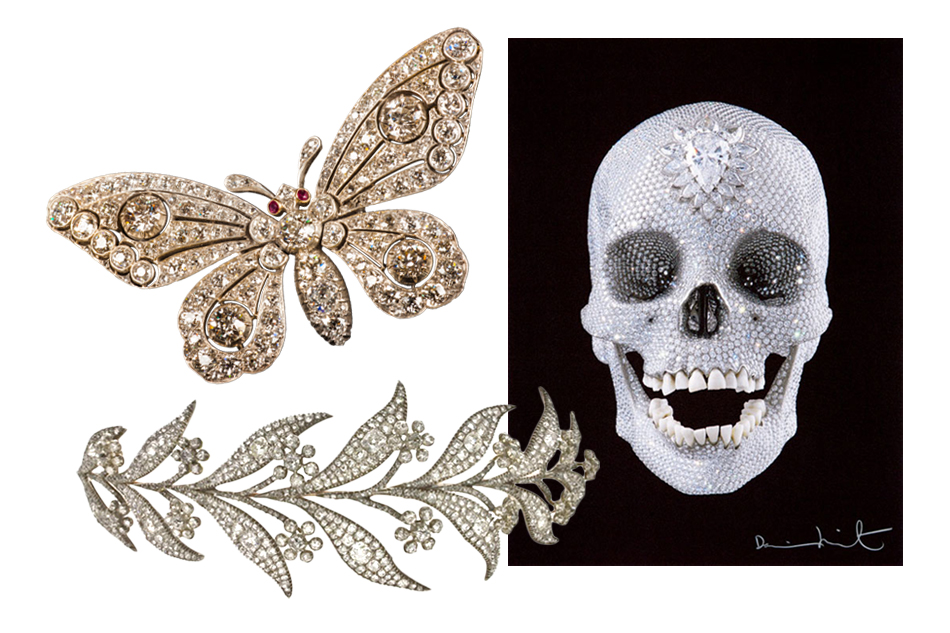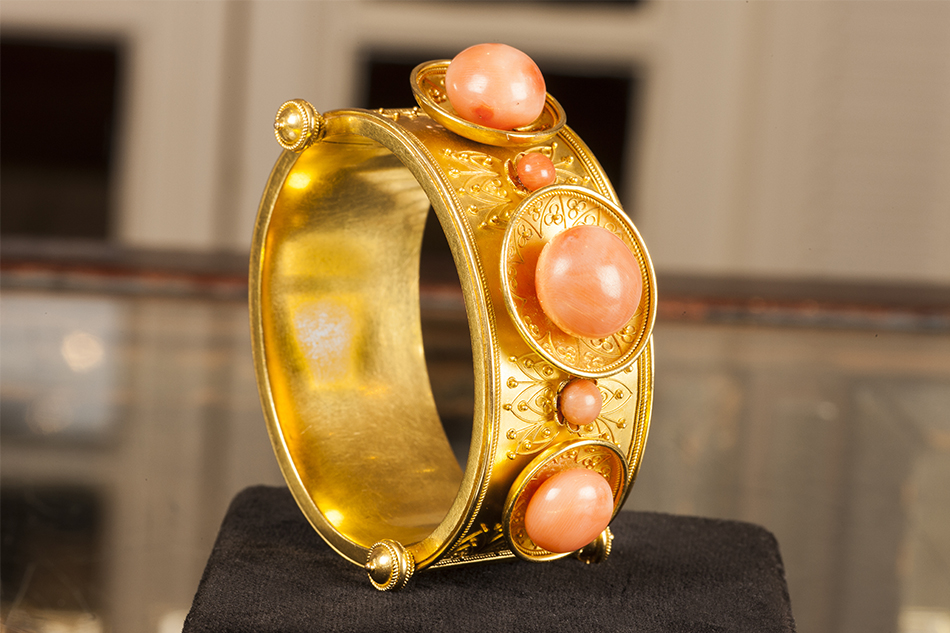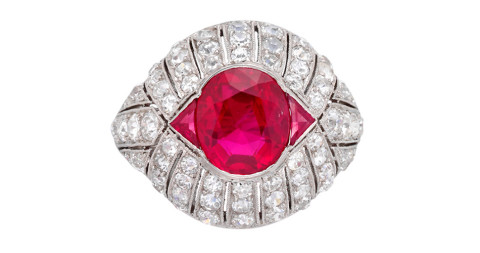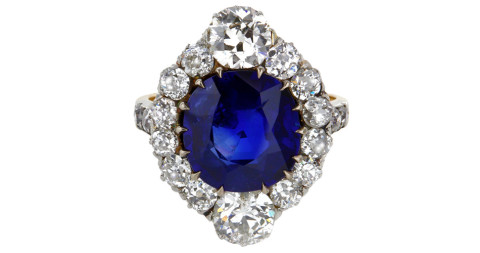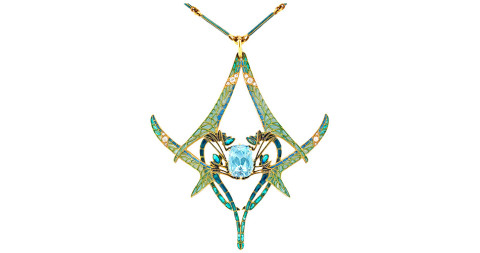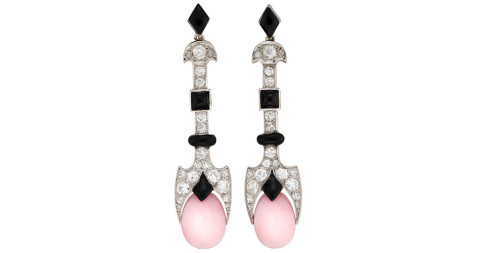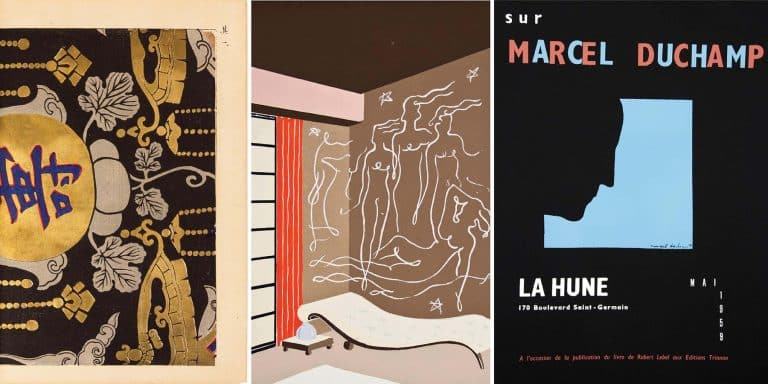
September 3, 2014The London jeweler Bentley & Skinner, which opened on Bond Street in 1934, relocated to Piccadilly in 2010. Top: In the new location, an eclectic mix of top-end jewelry fills Edwardian mahogany showcases that came from the original shop.
One of the oldest antique-jewelry specialists in London, Bentley & Skinner is something of an institution. Yet even institutions can lose their leases, as Bentley & Skinner did in 2010, requiring it to abandon the Bond Street location it had inhabited for 75 years. Luckily, the jeweler has ended up in a location of bustling splendor, on Piccadilly, one of London’s busiest and most historic thoroughfares, just a gemstone’s throw away from the Royal Academy. Here, the shop’s windows — set into a façade of glinting deep-red granite and temptingly filled with treasures — lure passersby like bees to honey. Some step out of the fast-flowing pedestrian parade to look at one window in particular, where one of Bentley & Skinner’s jewelers is hard at work, meditatively laboring inside his tool-lined atelier. All this occurs under the watchful but benign gaze of the white-gloved, immaculately uniformed doorman, Romeo (a talented tenor from Georgia), who has been a fixture since the jeweler’s days on Bond Street.
Inside, Mark Evans, Bentley & Skinner’s owner and managing director, explains how he recreated the atmosphere of the old space with new stonework and pillars framing Edwardian mahogany-and-glass cabinets and the original safes brought over from Bond Street. “We have the biggest safe in London,” Evans says proudly, “a huge, old-fashioned vault.” There is a small exhibition gallery downstairs, where he promotes the work of contemporary designers, and in the main store space, he carries on the tradition of holding regular musical soirees and concerts. (Most recently, the famed soprano Dame Felicity Lott gave an evening recital of arias by Lehar, Strauss and Donizetti.)

Bentley & Skinner’s owner and managing director, Mark Evans, is the great-nephew of John Sheldon, the proprietor of the original Bond Street business.
Evans, who joined the company in 1973, is the great-nephew of John Sheldon, an enterprising metallurgist of Russian descent who had bought the original business, Bentley & Co., from the Labour MP Monty Follick for £500 in 1934. Strangely enough, there is no record identifying the original Mr. Bentley, but Evans explains that his great-uncle purchased the jewelry purveyor because he liked the founder’s very English-sounding name. (Sheldon was an impassioned connoisseur whose extraordinary personal collection of antique jewelry sold at Sotheby’s after his death in 1985 for a princely sum.)
Skinner & Co, likewise a family concern, was established in 1881 and, having supplied jewelry to the royal family toward the end of Queen Victoria’s reign, received its first royal appointment in 1901 to King Edward VII. In 1998, the two jewelers amalgamated their businesses, and the royal connection continued: Shortly after the merger, Evans, as the proprietor of the newly formed Bentley & Skinner, was granted a Royal Warrant of Appointment as Jewellers and Silversmiths to H.M. Elizabeth II and HRH The Prince of Wales.
Today, Bentley & Skinner specializes in fine antique jewelry, silver and Fabergé pieces. The vast spectrum of styles and jewels includes Georgian topaz or chrysolite pendant crosses; superb examples of cannetille goldwork (little curled nests from the 1820s and ’30s made of fine gold wire and named for a style of Napoleonic embroidery, in which large aquamarines are embedded); early Victorian romanticist jewels (coy pansies, for example, and butterflies made of citrines and amethysts); massive High Victorian celebratory suites of rich burnished goldwork, sumptuous glossy garnets, plump gold-and-turquoise serpents; and cerebral Renaissance-revival and archaeological-style jewels. These give way to Edwardian elegance and whimsy (stars, crescents, chokers, lizards and frogs slithering with green demantoid garnets) and the refinement of the Belle Epoque (lace-like diamonds immaculately set in platinum).

Bentley & Skinner has a particular specialty in pieces by Fabergé, including this egg-shaped picture frame with opalescent white guilloche enamel, a pearl-rimmed photograph inset and a gold ribbon-bow surmount, made in St. Petersburg around 1910.
As for the Fabergé focus, that reflects John Sheldon’s ancestral roots and his personal interest in Russian works of art. Always on hand are exquisite gold-and-enamelled photo frames, cane handles, lorgnettes and poignantly romantic yet stylized Russian jewels in soft, burnished, reddish gold.
The journey through 19th- and 20th-century jewelry history continues with the symbolist fantasies of Art Nouveau and the chic, sharp geometric luxury of Art Deco. The shop’s myriad periods and styles offer both charming, easily wearable jewels and signed masterpieces for serious collectors by the likes of Lalique, Cartier, Lacloche, Castellani and Giuliano.
The shop also does a brisk business in engagement rings. “We still get young couples buying engagement rings because their grandparents had bought theirs here,” says Evans with pride. “There are very discerning young people who are interested now in antique jewelry. They want something different, individual, with charm and grace.” The choice is broadened by Bentley & Skinner’s own modern rings, handmade in traditional styles using old stones. Tiaras, the crowning glory to the vast repertoire, are hired out for weddings and balls; Downton Abbey’s Lady Mary wore a Bentley & Skinner Edwardian diamond tiara for her wedding in season three of the popular television show.
Old-fashioned, courteous customer service has always been of paramount importance at Bentley & Skinner, and Evans is supported by his sales staff of ten “jewelers,” as he calls them, all of whom are knowledgeable both in jewelry history and gemology and qualified as appraisers. “Everything is seen by me, but decisions are democratic, made as a team,” says Evans of acquiring inventory. “I believe the people selling the jewelry must love the jewelry.”

The interior of Bentley & Skinner’s shop, with its Edwardian showcases and pillars, balances grandeur with intimacy.
The breadth of jewelry on offer is matched by the range of clients, from the traditional to the artistic avant garde. One day in 2007, artist Damien Hirst, a longstanding Bentley & Skinner client with a deep appreciation of antique jewelry, came into the shop with an idea that was to bring an extra dimension and higher profile to this most restrained of heritage jewelers: to make a diamond-encrusted, platinum cast of an 18th-century human skull. Evans, stunned at the time, believes it to be “the biggest commission to a jeweler in two-hundred years.” The artwork, named For the Love of God, took two years to complete; the skull had to be cut into sections that were cast in platinum and then painstakingly pavé-set with some 8,600 top-quality diamonds. (A pale pink, pear-shaped 52.40-carat diamond, nicknamed the Skull Star, is embedded in the forehead.) The controversial diamond skull drew huge attention — not least of all for its astronomical price tag, supposedly around $100 million — and rumors about whether it had been bought and by whom abound. (Evans says he has had no more news since the skull was reported to have been purchased by a consortium of investors later in 2007.)
Whatever the opinion of the art world, this was a modern-day vanitas object, a thought-provoking reminder of life’s shortness and fragility challenged by the eternity and immutability of the diamond. And it’s living proof that the appeal of Bentley & Skinner, with its unflinching traditionalism, authenticity and style, is as enduring as ever.



